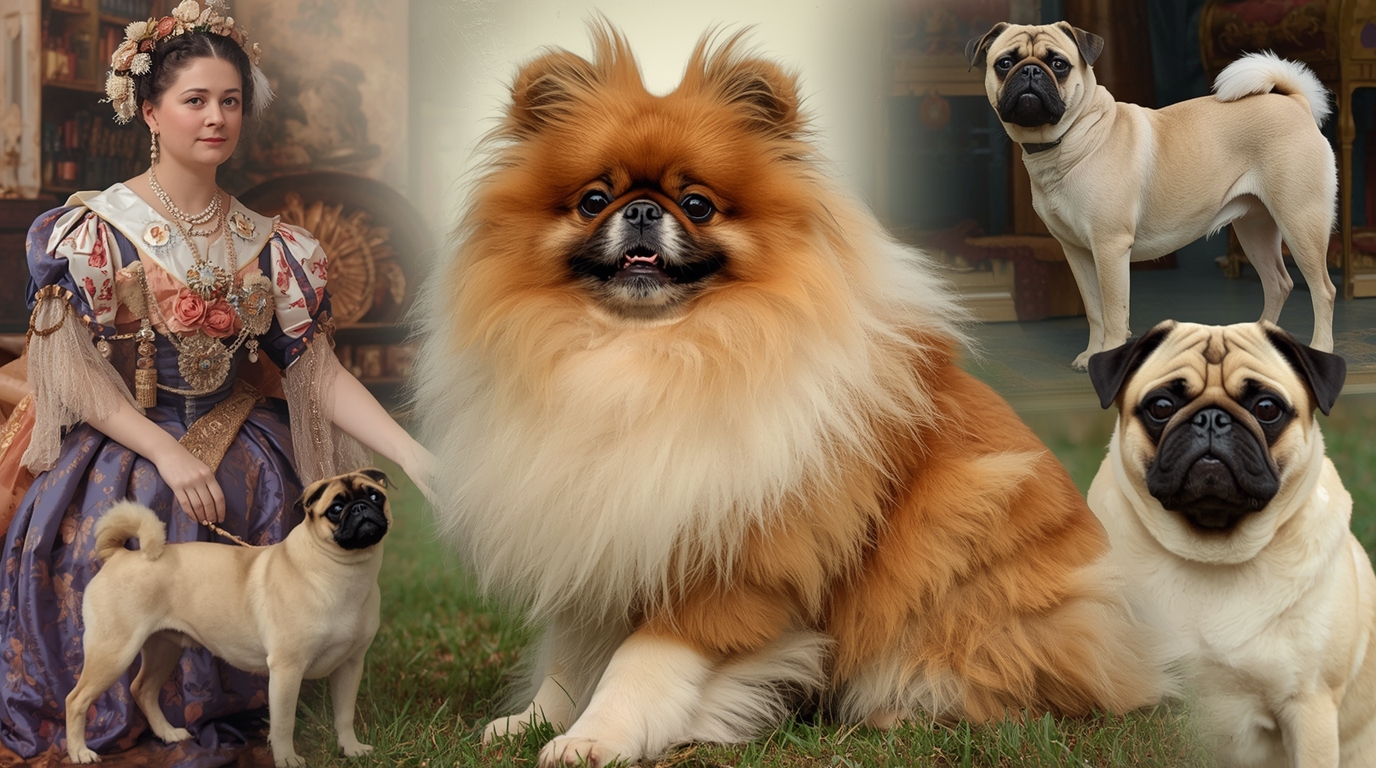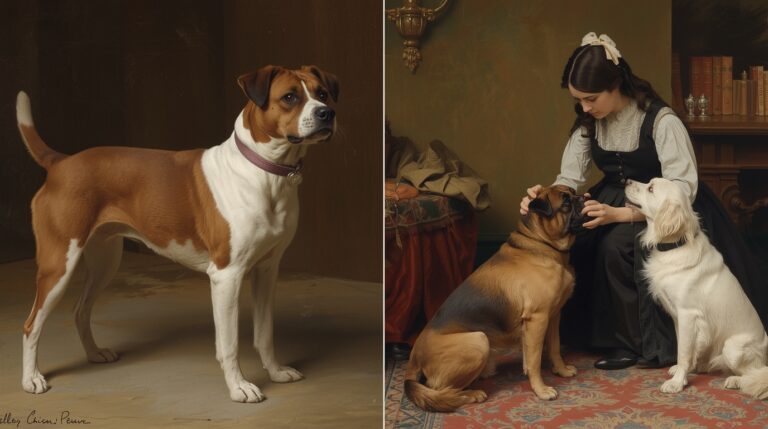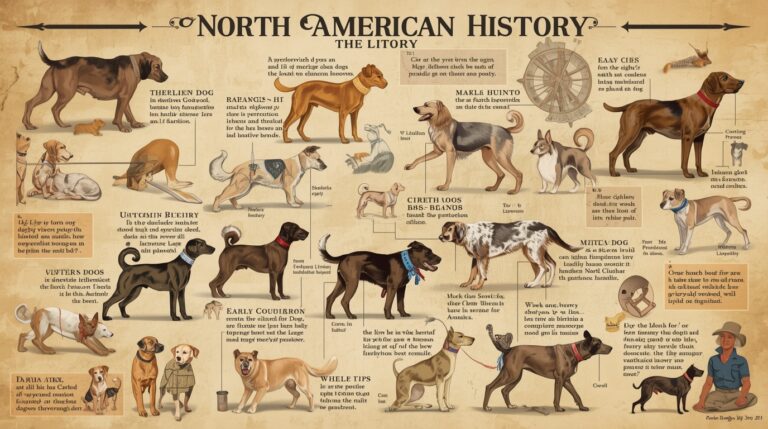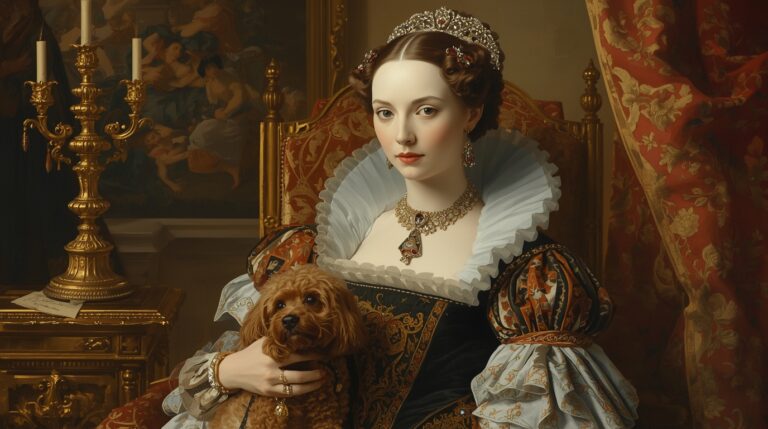Dog Breeding in the Victorian Era

What Was the Victorian Era?
The Victorian Era, spanning 1837 to 1901, was a time of industrial progress, expanding imperial power, and strict social stratification in Britain. It also saw a shift in how animals, especially dogs, were perceived — not as farmhands, but family members.
How Dogs Were Viewed Before the 1800s
Before Victorian influence:
- Dogs were utilitarian: hunters, guards, herders
- Few records of standardized breeds existed
- Little emphasis was placed on aesthetics or lineage
Dogs were functional creatures. The idea of owning a dog purely for its appearance or companionship was rare before the 19th century.
Queen Victoria’s Role in Dog Breeding
Queen Victoria, an avid dog lover, personally owned over 30 breeds in her lifetime. She famously adored the Pomeranian, importing it from mainland Europe and encouraging its downbreeding from 20 lbs to 5 lbs.
Her influence:
- Made lap dogs fashionable
- Sparked interest in foreign and exotic breeds
- Elevated dog ownership to a royal lifestyle choice
The Creation of The Kennel Club (UK)
The first formal dog show occurred in Newcastle in 1859. By 1873, the Kennel Club was founded — the world’s first national dog registry.
Its goals:
- Establish breed standards
- Create rules for dog shows
- Track pedigree lines
The Emergence of Pedigree Culture
The term “pedigree” became synonymous with social status. Much like noble bloodlines, dog bloodlines were revered, tracked, and valued.
- Purebred dogs had certificates and lineage books
- Breeding was seen as a science and artform
- Only certain people were allowed to enter dogs into shows
The First Breed Standards
Early breed standards defined:
- Size
- Color
- Temperament
- Conformation (body structure)
Judging moved from working ability to appearance conformity, giving rise to the modern concept of “show dogs.”
Selective Breeding and Eugenics Ideology
Inspired partly by Charles Darwin, Victorian breeders applied the idea of artificial selection to canines.
Traits were exaggerated:
- Bulldogs were bred with shorter snouts
- Pugs developed more compact bodies
- Spaniels gained longer ears and silkier coats
This also brought in eugenic ideals, tying dog breeding to human classism and racial theory.
also read this The History of Dog Breeds
Popular Breeds in Victorian England
Bulldogs
Symbol of British strength, bred from bull-baiting dogs to more docile show dogs.
Fox Terriers
Favored for their energy and vermin-hunting ability, then bred for white coats and slim heads.
Collies
Originally sheepdogs, refined under Queen Victoria’s patronage for elegance and domesticity.
Pugs
Exotic imports from China that became aristocratic accessories.
Cavalier King Charles Spaniel
Linked to Stuart royalty, revived in Victorian times as a lap companion.
Pug Obsession in Aristocratic Circles
Pugs were imported through Dutch and Portuguese traders from China. In Victorian homes:
- They were pampered and dressed
- Their squashed face was exaggerated through breeding
- They became staples of parlor portraits and lady’s laps
Fashionable Dogs and Lapdog Trends
Dogs became part of the fashion of the elite. Women chose breeds that:
- Matched their attire
- Could be carried or perched in parlors
- Appeared in family photo albums and oil paintings
The Role of Dog Shows in Victorian Society
Dog shows weren’t just for fun — they were social battlegrounds.
- Show results influenced marriage prospects, land ownership, and nobility discussions
- Winning breeds were marketed and sold at higher prices
- Newspapers covered shows like political events
The Influence of Art and Photography
Dog photography boomed:
- Dogs were posed in anthropomorphic portraits
- Painted beside masters in military uniforms or fine gowns
Canine imagery was an extension of family identity and refinement.
Crossbreeding and Experimental Breeds
Victorian breeders loved experimentation:
- Created new types like the Bedlington Terrier, Bull Terrier, and Dandie Dinmont
- Crossed for coat texture, snout shape, gait
But ethical problems emerged — inbreeding and genetic disorders increased rapidly.
Working Breeds During the Era
Despite the glamour, working-class Brits relied on dogs for:
- Hunting (Lurchers, Hounds)
- Guarding (Bullmastiffs)
- Sheep Herding (Border Collies)
Some breeds straddled both worlds — prized for labor and looks.
Canine Behavior and Victorian Expectations
Dogs were expected to mirror Victorian ideals:
- Males: brave, protective, assertive
- Females: gentle, obedient, nurturing
Behavior was bred into gendered stereotypes, affecting training and role assignments.
Impact of Industrialization on Dog Ownership
Urban life led to:
- Smaller dog sizes for apartments
- Need for quieter, odorless breeds
- Rise in pet hygiene tools, dog collars, and leashes
Middle-class families kept pets as part of respectable living.
Veterinary Science and Health Concerns
The era had minimal veterinary infrastructure, leading to:
- High mortality rates from inbreeding
- Misunderstanding of genetic diseases
- Basic vaccinations emerging toward the century’s end
Charles Darwin’s Commentary on Dog Breeding
In his book “The Variation of Animals and Plants Under Domestication,” Darwin analyzed:
- Artificial selection through canine traits
- The ways breeders unconsciously influenced genetics
- Dogs as evidence of evolutionary pressure from humans
Dog Breeding as a Hobby and Science
Wealthy Victorians engaged in:
- Cataloging breeds
- Hosting seminars on genetics
- Founding early canine universities and breed registries
Colonial Expansion and Imported Breeds
With the British Empire expanding:
- Dogs were brought from India (Pariah dogs), Africa (Basenjis), and Egypt (Salukis)
- These breeds were exoticized and rebranded for Western tastes
Gender and Dog Breeding in the Victorian Household
- Women led small dog breeding: Shih Tzus, Pomeranians
- Men led hound breeding and judging
- Dog keeping became an expression of domestic gender roles
The Lasting Impact on Modern Breeds
Many modern breeds owe their standardization, name, and shape to this period:
- Pomeranian, Bulldog, Fox Terrier all shrunk or stylized in the 1800s
- Victorian values of purity, beauty, and performance remain in today’s kennel clubs
Ethical Critiques of Victorian Breeding
Consequences include:
- Rise in hereditary disease (hip dysplasia, brachycephaly)
- Deformities prioritized over function
- Today’s critics trace modern breed problems back to Victorian excess
Conclusion: The Era That Reshaped the Canine World
Dog breeding in the Victorian Era was revolutionary — and controversial.
It gave rise to pedigree culture, show dog institutions, and breed aesthetics. Yet, it also birthed the ethical challenges we face in modern canine care. The era forever altered not only how dogs look, but how we see them — not as laborers, but as companions, identities, and legacies.





